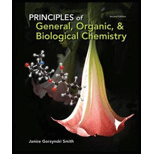
Concept explainers
a.
Interpretation:
The chirality center present in hydroxydihydrocitronellal compound has to be determined.
Concept introduction:
Chirality center:
When a carbon atom is bonded to four different groups, then that carbon is named as chiral carbon and it is called as chirality center. Generally, the carbon atom contains tetrahedral valency, therefore it bonded to four atoms or molecules. The chiral center is bonded with four different elements or groups. If the single carbon atom is bonded to two or more identical group or atom, then it is also not considered as chiral carbon. In addition to this, if the carbon atom contains multiple bond then it does not able to bond with four different groups then it is not considered to be as a chirality center.
b.
Interpretation:
For a given hydroxydihydrocitronellal compound enantiomers, Fischer projection has to be drawn.
Concept introduction:
Fischer projections:
In Fischer projection, the chirality center of the organic compounds are drawn using the following convention. First, the carbon atom is placed at the meeting point of the two lines of the cross. In a tetrahedron structure, the horizontal bonds are comes forward is denoted by wedges. The vertical bonds are go backside it is denoted by dashed lines. Finally, Fischer projection structure is abbreviated by cross formula.
Enantiomers:
Enantiomers are mirror image of one another and these are chiral molecules,but that are non superimposable on one another.
Want to see the full answer?
Check out a sample textbook solution
Chapter 12 Solutions
Principles of General Organic & Biological Chemistry
- € CH3-CH-C-O-CH2-CH2-CH3 + NaOH A? Specifically, in the drawing area below draw the condensed structure of the product, or products, of this reaction. (If there's more than one product, draw them in any arrangement you like, so long as they aren't touching.) If there aren't any products because this reaction won't happen, check the No reaction box under the drawing area. Predict the products of this organic reaction: CH3 O Click anywhere to draw the first atom of your structure. No reaction ✓ Garrow_forwardA molecule can have a temporary or permanent depending on the structure and the way the electrons can move. True Falsearrow_forwardedict the products of this organic reaction: CH3 O A CH3-CH-C-NH2 + H2O + HCI ? Specifically, in the drawing area below draw the condensed structure of the product, or products, of this reaction. If there's more than one product, draw them in any arrangement you like, so long as they aren't touching. If there aren't any products because this reaction won't happen, check the No reaction box under the drawing area. Click anywhere to draw the first atom of your structure. No Reaction planation Check 2025 McGraw Hill LLC. All Rights Reserved. Terms of Use | Privacy Center +arrow_forward
- Draw the mechanism for the following reaction: OH A few notes: CI O • You may assume that each reagent is present in whatever amount you need to draw your mechanism. • To save you some time, one of the starting materials has been copied into the first step of the drawing area. AP Add/Remove step Cl Click and drag to start drawing a structure.arrow_forwardWhat is the missing reactant in this organic reaction? CH3 O [0] R CH3-CH-C-OH Specifically, in the drawing area below draw the condensed structure of R. If there is more than one reasonable answer, you can draw any one of them. If there is no reasonable answer, check the No answer box under the drawing area. Note: the organic equation above only shows the important organic reactant and product. Minor small-molecule reactants or products (like H₂O) are not shown. No Answer Click anywhere to draw the first atom of your structure. ×arrow_forwardPredict the product of this organic reaction: O CH3 A NH3 + HO–C—CH—CH, P+H₂O Specifically, in the drawing area below draw the condensed structure of P. If there is no reasonable possibility for P, check the No answer box under the drawing area. No Answer Click anywhere to draw the first atom of your structure. A 5arrow_forward
- For a reaction to be spontaneous, the Gibbs Free Energy must be less than zero. True or Falsearrow_forwardWhich of the following reactions will be exothermic? a) Reaction has enthalpy less than zero. b) Reaction has enthalpy greater than zero. c) Reaction has entropy less than zero. d) Reaction has entropy equal to zero.arrow_forwardHow many valence electrons are used in predicting the Lewis Dot structure of CH4? a) 8 b) 6 c) 10 d) 2arrow_forward
- How many valence electrons are used in predicting the Lewis Dot structure of CO2? a) 32 b) 26 c) 24 d) 16arrow_forwardHow many valence electrons are used in predicting the Lewis Dot structure of NO2? a) 17 b) 12 c) 5 d) 10arrow_forwardA compound that is bonded with an ionic bond is unlikely to dissolve in water. True or Falsearrow_forward
 Macroscale and Microscale Organic ExperimentsChemistryISBN:9781305577190Author:Kenneth L. Williamson, Katherine M. MastersPublisher:Brooks Cole
Macroscale and Microscale Organic ExperimentsChemistryISBN:9781305577190Author:Kenneth L. Williamson, Katherine M. MastersPublisher:Brooks Cole
